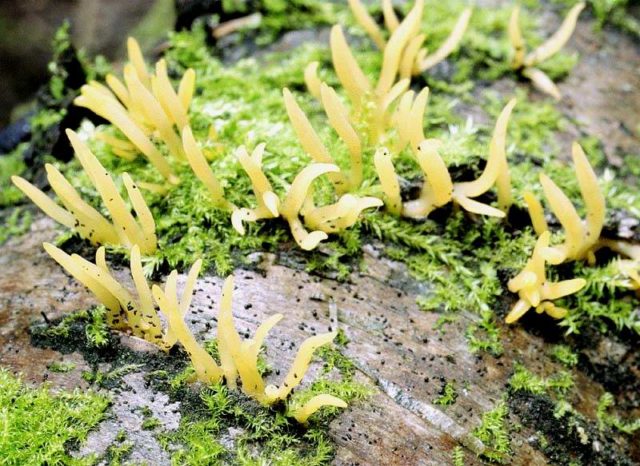Content
Kalocera cornea is a conditionally edible specimen of the Dacrimycetaceae family. The species can be recognized by its bright color and horn-like shape. The fungus is widespread everywhere, prefers decayed deciduous wood. It starts bearing fruit from the first warm days. To recognize this representative of the forest kingdom, you need to read the description, view photos and videos.
What do horny caloceres look like?
This forest dweller is difficult to confuse with other representatives of the mushroom kingdom. Since the species has a horn-like, clavate shape, or some resemblance to miniature petals. Very often, fruiting bodies grow together to form ribbed ribbons. The mushroom is small in size, reaching no more than 2 cm in height and 3 mm in thickness.
The surface of young specimens is shiny, painted in bright orange color, with age, the color changes to dirty orange. The pulp is elastic, gelatinous, has no taste or smell. A hymenophore is located over the entire surface of the fruiting body. Reproduction takes place in miniature, colorless spores, which are in a snow-white powder.
Where do horny caloceres grow?
Calocera is widespread throughout Russia. It prefers to grow in damp, shaded areas, on stumps and damaged deciduous trees, rarely found in coniferous forests. Mushrooms grow in large families, from early spring to the first frost.
Is it possible to eat horny calocera
This copy belongs to the 4th group of edibility. But due to the lack of taste and smell in cooking, it is rarely used. Due to its beautiful color, many cooks, after long boiling, use it as a decoration for cold and meat dishes.
In Russian forests, you can find edible and inedible counterparts:
- Dakrimitses disappearing - an inedible representative of the mushroom kingdom. The young fruiting body has an irregular drop or ball shape. During growth, the surface is colored orange-red, then the color changes to bright lemon. In dry weather, the mushroom dries up. The gelatinous pulp, when mechanically damaged, secretes a bright red juice.
- Deer horns - conditionally edible species growing in small groups on rotten wood. The mushroom can be recognized by its bright yellow color and branch-like shape of the fruiting body. Begins fruiting from July to late September. Despite the lack of taste and smell, many mushroom pickers eat this species. They can be boiled, stewed, dried and fried.Important! Because of their bright color, European chefs boil deer horns and use them as a decoration for cold dishes.
Conclusion
Horny Kalocera is a beautiful and vibrant forest inhabitant that occurs throughout the warm period in deciduous forests. Since the pulp does not have a mushroom taste and smell, this specimen is rarely eaten. In order not to confuse the species with inedible brethren, experienced mushroom pickers recommend not collecting this species, but simply admire it.












